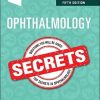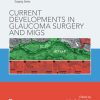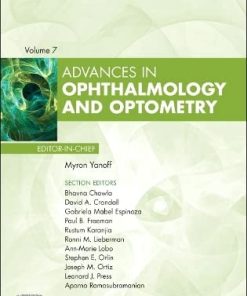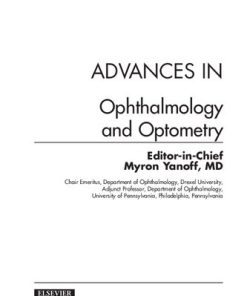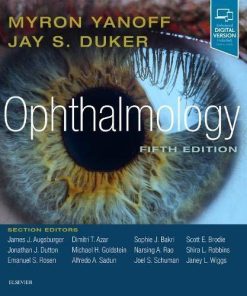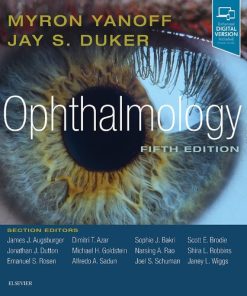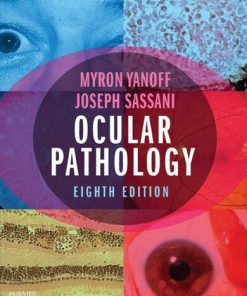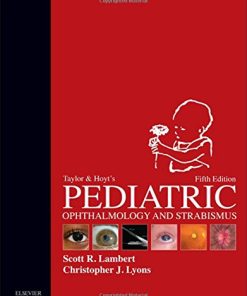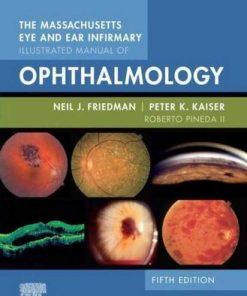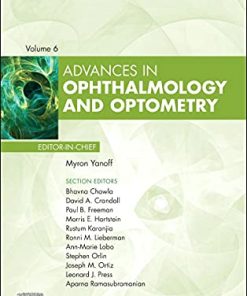(Ebook PDF) Ophthalmology 5th Edition by Myron Yanoff, Jay Duker 0323528228 9780323528221 full chapters
$50.00 Original price was: $50.00.$25.00Current price is: $25.00.
Ophthalmology 5th Edition by Myron Yanoff, Jay S. Duker – Ebook PDF Instant Download/DeliveryISBN: 0323528228, 9780323528221
Full download Ophthalmology 5th Edition after payment.
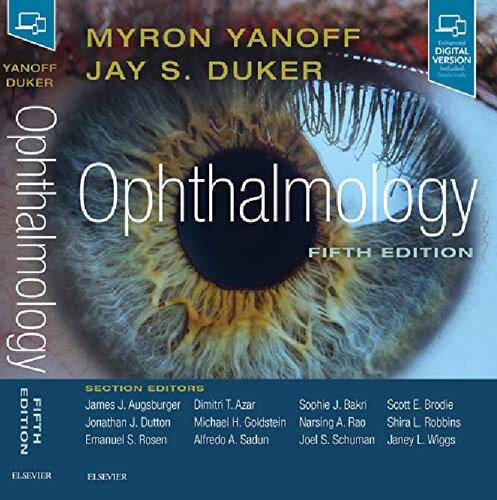
Product details:
ISBN-10 : 0323528228
ISBN-13 : 9780323528221
Author : Myron Yanoff, Jay S. Duker
Long considered one of ophthalmology’s premier texts, this award-winning title by Drs. Myron Yanoff and Jay S. Duker remains your go-to reference for virtually any topic in this fast-changing field. In a single, convenient volume, it offers detailed, superbly illustrated guidance on nearly every ophthalmic condition and procedure you may encounter, making it a must-have resource no matter what your level of experience. Extensive updates throughout keep you current with all that’s new in every subspecialty area of the field.
Ophthalmology 5th Table of contents:
Part 1 Genetics
1.1 Fundamentals of Human Genetics
Key Features
DNA and the Central Dogma of Human Genetics
Human Genome
Basic Mendelian Principles
Mutations
Genes and Phenotypes
Patterns of Human Inheritance
Molecular Mechanisms of Disease
Gene Therapy
Key References
References
1.2 Molecular Genetics of Selected Ocular Disorders
Key Features
Introduction
Dominant Corneal Dystrophies
Aniridia, Peter’s Anomaly, Autosomal Dominant Keratitis
Rieger’s Syndrome
Juvenile Glaucoma
Congenital Glaucoma
Nonsyndromic Congenital Cataract
Retinitis Pigmentosa
Stargardt Disease
X-Linked Juvenile Retinoschisis
Norrie’s Disease
Sorsby’s Macular Dystrophy
Gyrate Atrophy
Color Vision
Retinoblastoma
Albinism
Leber’s Optic Neuropathy
Congenital Fibrosis Syndromes and Disorders of Axon Guidance
Autosomal Dominant Optic Atrophy
Complex Traits
Key References
References
1.3 Genetic Testing and Genetic Counseling
Key Features
Genetic Testing
Genetic Counseling
Key References
References
Part 2 Optics and Refraction
2.1 Light
Key Features
Introduction
Geometrical Optics
Basic Stigmatic Optics
Astigmatic Optics
Wave Properties of Light
Key References
References
2.2 Optics of the Human Eye
Key Features
Introduction
Cornea
Pupil
Lens
Accommodation
Scattering
Aberrations
Retina
Resolution and Focal Length
Refractive Errors
Key References
References
2.3 Clinical Refraction
Key Features
Introduction
History
Visual Acuity
Spherical Equivalent
Detecting Astigmatism
Refracting at Near
Additional Subjective Techniques
Retinoscopy
Key References
References
2.4 Correction of Refractive Errors
Key Features
Introduction
Spectacle Correction
Contact Lenses
Intraocular Lenses
Keratorefractive Surgery
Corneal Inlays
Key References
References
2.5 Ophthalmic Instruments
Key Features
Introduction
Direct Ophthalmoscope
Binocular Indirect Ophthalmoscope
Fundus Camera
Optical Coherence Tomography
Slit-Lamp Biomicroscope
Slit-Lamp Fundus Lenses
Goldmann Applanation Tonometer
Operating Microscope
Keratometer and Corneal Topographer
Lensmeter
Automated Refractor
Magnifying Devices
Key References
References
2.6 Wavefront Optics and Aberrations of the Eye
Key Features
Introduction
Ray Aberrations
The Wavefront Approach to Aberrations
Spherical Aberration
Coma
Distortion
Field Curvature (FC)
Oblique Astigmatism (OA)
Higher-Order Aberrations (HOA)
Chromatic Aberration
Measurement of Ocular Aberrations
An Overall Perspective on Aberration Theory
Key References
References
Part 3 Refractive Surgery
3.1 Current Concepts, Classification, and History of Refractive Surgery
Key Features
Associated Features
Introduction
Excimer Laser and Ablation Profiles
Concepts in Development
Classification of Refractive Procedures
Summary
Key References
References
3.2 Preoperative Evaluation for Refractive Surgery
Key Features
Introduction
Ophthalmic Examination
Ancillary Testing
Key References
References
3.3 Excimer Laser Surface Ablation
Key Features
Introduction
Ablation Profiles
Indications
Preoperative Evaluation
PRK Surgical Technique
Results
Complications
Conclusions
Key References
References
3.4 LASIK
Key Features
Associated Features
Historical Review
LASIK
LASIK Enhancements
LASIK in Complex Cases
Summary
Key References
References
3.5 Small Incision Lenticule Extraction (SMILE)
Key Features
Introduction
Femtosecond Laser System
Treatment Range for SMILE
Patient Evaluation
Surgical Procedure
Complications
Higher-Order Aberrations
Biomechanical Stability
Refractive and Visual Outcome
Retreatments
Conclusions
Key References
References
3.6 Wavefront-Based Excimer Laser Refractive Surgery
Key Features
Introduction
Wavefront Optics
Higher-Order Aberrations
Ideal Corneal Shape
Measurements of Wavefront Aberrations
Quality of Vision and Measures of Optical Quality
Wavefront-Measuring Devices
Wavefront-Based Surgery
Results
Wavefront Platforms (Table 3.6.1)
Conclusions
Key References
References
3.7 Phakic Intraocular Lenses
Key Features
Associated Features
Introduction
History of Phakic Lenses
Indications of Phakic Lenses
Advantages and Disadvantages of Phakic Iols
Intraocular Lens Power Calculation
Visual Outcomes
Anterior Chamber Angle-Supported Phakic Intraocular Lenses
Iris-Fixated Phakic Intraocular Lenses
Posterior Chamber Phakic Intraocular Lenses
Bioptics
Conclusion
Key References
References
3.8 Astigmatic Keratotomy
Key Features
Historical Review
Surgical Techniques for Astigmatic and Radial Keratotomy
Outcome Comparison for Various Astigmatism Correction Methods
Complications and Management of Astigmatism Correction Methods
Conclusions
Key References
References
3.9 Intrastromal Corneal Ring Segments and Corneal Cross-Linking
Key Features
Introduction
Intracorneal Ring Segments
Surgical Procedure: ICRS
Surgical Procedure: CXL
CXL Clinical Outcomes
Combining ICRS With CXL
Conclusions
Key References
References
3.10 Surgical Correction of Presbyopia
Key Features
Introduction
Presbyopia Correction at the Corneal Level
Key References
References
Part 4 Cornea and Ocular Surface Diseases
Section 1 Basic Principles
4.1 Corneal Anatomy, Physiology, and Wound Healing
Key Features
Introduction
Corneal Wound Healing
Key References
References
4.2 Anterior Segment Imaging Modalities
Key Features
Introduction
Anterior Segment Optical Coherence Tomography
Specular Microscopy
Ultrasound Biomicroscopy
Meibography
In vivo Confocal Microscopy
Topography and Tomography
Wavefront Analysis
Summary
Key References
References
Section 2 Congenital Abnormalities
4.3 Congenital Corneal Anomalies
Key Features
Introduction
Size and Shape Anomalies
Anomalies of Corneal Clarity
Key References
References
Section 3 External Diseases
4.4 Blepharitis
Key Features
Associated Features
Introduction
Epidemiology
Pathogenesis
Ocular Manifestations
Diagnosis and Ancillary Testing
Treatment
Key References
References
4.5 Herpes Zoster Ophthalmicus
Key Features
Associated Features
Epidemiology and Pathogenesis
Clinical Manifestations
Herpes Zoster Ophthalmicus in Acquired Immune Deficiency Syndrome
Diagnosis
Management
Prevention
Key References
References
Section 4 Conjunctival Diseases
4.6 Conjunctivitis
Key Features
Infectious Conjunctivitis
Noninfectious Conjunctivitis
Key References
References
4.7 Allergic Conjunctivitis
Key Features
Acute Allergic Conjunctivitis: Seasonal/Perennial
Chronic Atopic Keratoconjunctivitis
Vernal Conjunctivitis
Treatment of Allergic/Atopic Keratoconjunctivitis
Allergic Dermatoconjunctivitis
Microbial Allergic Conjunctivitis
Giant Papillary Conjunctivitis
Key References
References
People also search for Ophthalmology 5th:
grand rapids ophthalmology
optometry vs ophthalmology
pediatric ophthalmology
american academy of ophthalmology
raleigh ophthalmology
Tags:
Ophthalmology,Myron Yanoff,Jay Duker,convenient
You may also like…
Medicine - Ophthalmology
Uncategorized
Medicine & Health Science
Medicine - Ophthalmology
Medicine
Advances in Ophthalmology and Optometry, 2021 (Volume 6-1) (Advances, Volume 6-1) Myron Yanoff Md


